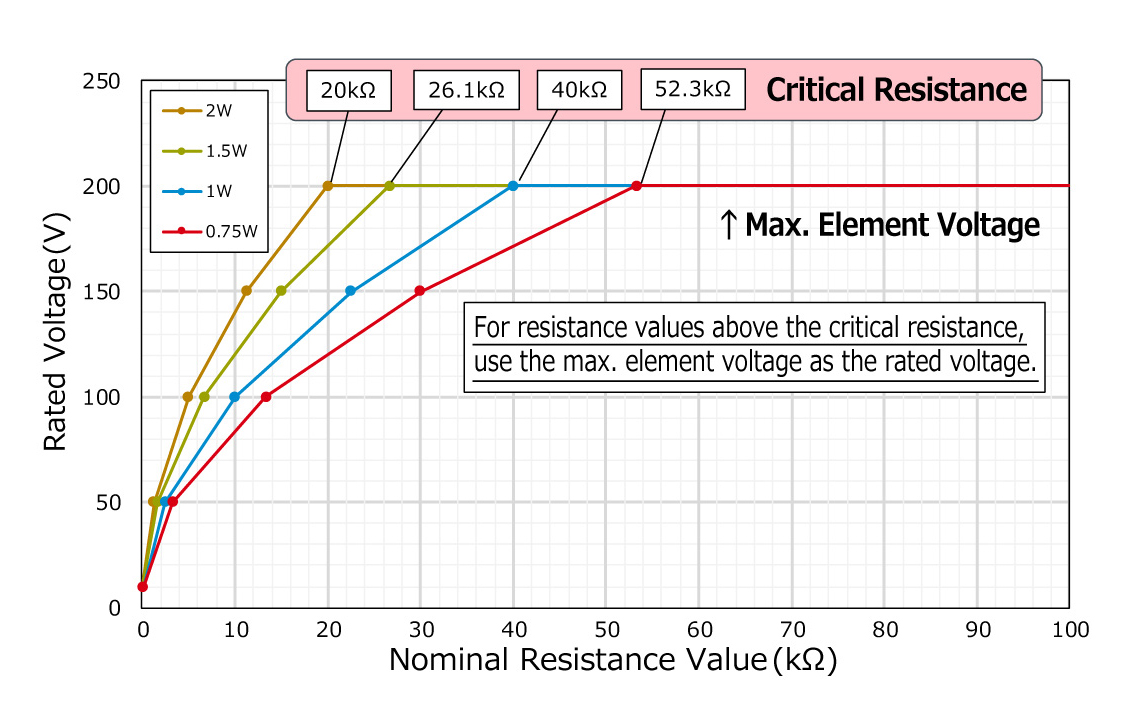What is Rated Voltage?
Precautions when using resistors
Both the rated voltage and max. element voltage must be considered when using a resistor.
Here we will define the two related terms of rated voltage and max. element voltage and explain their relationship.
We will also discuss the relevant terms of critical resistance and max. overload voltage.
Rated Voltage
Rated voltage is the max. AC or DC voltage that can be continuously applied at the rated ambient temperature or terminal temperature.
In the case of resistors, even at the same rated power, the voltage that can be applied will differ depending on the resistance value, and can be calculated from the rated power and resistance value using the following formula (1).

The formula for rated voltage (1) can be derived from Ohm’s Law (2) and power calculation formula (3), and is proportional to the resistance value.

Although it may seem that the higher the resistance value the more voltage that can be applied to the element, this is not the case.
Max. element voltage
The max. element voltage is the limiting value of voltage that can be continuously supplied, and applies only to resistance values in the region above the specified resistance value.
・ Relationship between rated voltage and max. element voltageThe rated voltage is calculated from formula (1), but for high resistances the voltage calculated by this expression may become too high, which can cause the element to be destroyed if continuously applied.
Therefore, the value calculated in formula (1) is compared with the max. element voltage, and the smaller value is defined as the rated voltage.
This max. element voltage is specified for each product series and size.

[Defining the Rated Voltage]
Ex:For a rated power of 1W, 100kΩ resistance, and 200V max. element voltage,
・ Rated Voltage = √ (Rated Power x Resistance) = √ (1.0 x 100000) ≒ 316V
However, since the max. element voltage is 200V, a voltage higher than 200V cannot be applied. Therefore, the rated voltage for this product is 200V.
■ Pattern 1
Calculated value of √(Rated Power x Resistance) < Max. Element Voltage
→ Use the calculated value of √(Rated Power x Resistance) as the Rated Voltage.■ Pattern 2
Calculated value of √(Rated Power x Resistance) > Max. Element Voltage
→ Use the value of Max. Element Voltage as the Rated Voltage.Compare the value calculated from the above formula with the max. element voltage, and define the smaller of the two as the rated voltage of the product.
critical resistance
Critical resistance refers to the specific resistance described in the max. element voltage above.

[Critical resistance when the max. element voltage is 200V]
Max. overload voltage
The max. overload voltage is the maximum voltage that can be applied during overload testing (JIS C 5201-1 4.13)[and used only for overload testing].
As with the max. element voltage, this value applies to the high resistance region, and if the overload voltage calculated by the (rated voltage) x (guaranteed factor for each product) increases, damage due to over-voltage may occur at high resistances.
Therefore, the max. overload voltage is defined as the upper voltage limit that can be used during overload testing.
Resistor Product Family



